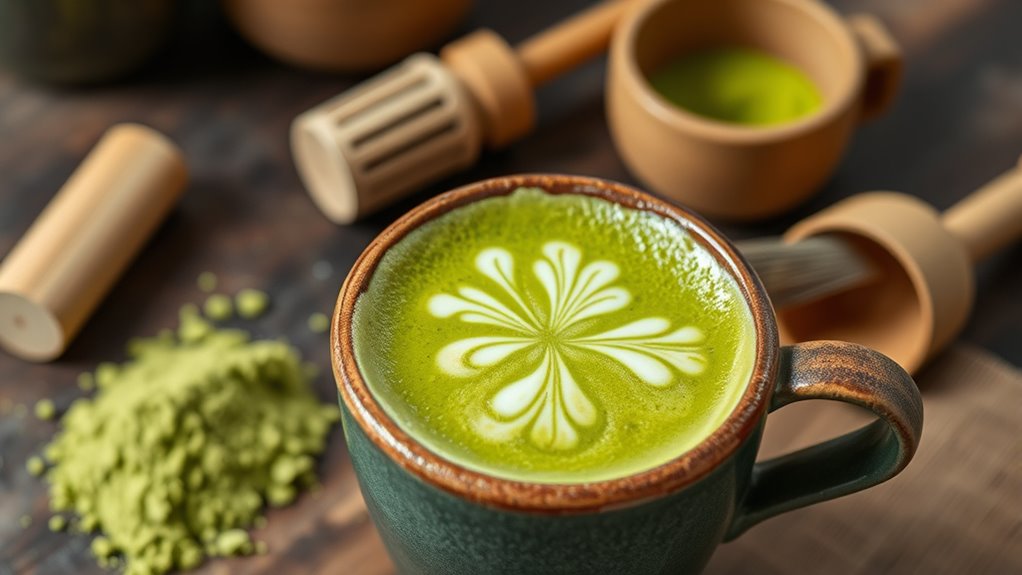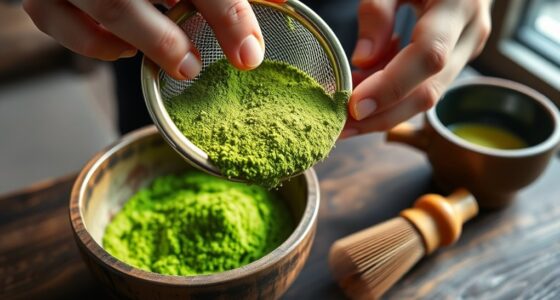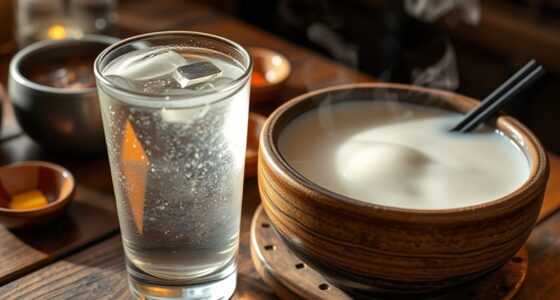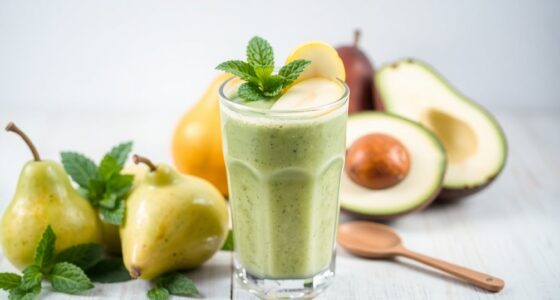Matcha is more than just a trend; it’s a mindful tradition that enriches your daily routine. Made from ground green tea leaves, it offers a vibrant color and a rich, umami flavor, along with calming and invigorating effects. Its cultural significance promotes presence and connection to nature, while health benefits like antioxidants and L-theanine support your well-being. Discover how this timeless practice can transform your lifestyle—explore further to embrace its full potential.
Key Takeaways
- Matcha’s traditional preparation promotes mindfulness, connecting modern routines with centuries-old cultural rituals.
- Its rich antioxidant content offers long-term health benefits beyond a simple beverage.
- The vibrant green color and complex flavor profile appeal to discerning tea enthusiasts.
- Matcha’s versatility allows it to be used in various culinary creations, from drinks to baked goods.
- Incorporating matcha encourages a slow, mindful approach to daily life, embodying values of connection and appreciation.

Have you ever wondered what makes matcha so popular among tea enthusiasts? It’s not just a fleeting trend; it’s a beverage that has captured the hearts of many because of its unique qualities and cultural significance. Unlike traditional teas, matcha is made from finely ground green tea leaves, which means you consume the entire leaf in powdered form. This process results in a vibrant green color and a rich, umami flavor that sets it apart from other teas. When you whisk it into hot water, you’re not just brewing a drink—you’re engaging in a centuries-old ritual that emphasizes mindfulness and appreciation for the present moment.
One of the main reasons matcha has gained such widespread popularity is its remarkable health benefits. Because you ingest the whole leaf, you get a concentrated dose of antioxidants, including catechins, which are known for fighting free radicals and reducing inflammation. These antioxidants can boost your immune system, improve your skin, and even support weight management. Additionally, the quality of matcha can significantly influence the level of health benefits you receive, making choosing high-quality matcha essential.
Matcha also contains L-theanine, an amino acid that promotes relaxation without drowsiness, helping you stay alert and focused. Many people turn to matcha as a natural energy booster that provides a gentle lift without the jitteriness often associated with coffee. Its caffeine content is balanced by L-theanine, which creates a calming effect, making it a perfect pick-me-up for busy mornings or stressful afternoons.
Beyond its health perks, matcha offers a sensory experience that’s both calming and invigorating. When you prepare it properly, the process becomes almost meditative—whisking the powder into hot water to create a frothy, velvety drink. The aroma alone can be soothing, with grassy and earthy notes that evoke a sense of connection to nature.
Drinking matcha also encourages a slow, mindful approach to your daily routine, whether you’re savoring it at breakfast or taking a moment to unwind in the afternoon. Its versatility extends beyond traditional tea cups; you can incorporate matcha into lattes, smoothies, baked goods, and even savory dishes, making it a creative ingredient that fits seamlessly into modern culinary trends.
Ultimately, matcha’s popularity isn’t just about taste or health benefits. It’s about embracing a lifestyle that values mindfulness, quality, and tradition. When you choose matcha, you’re not only enjoying a flavorful beverage but also participating in a cultural heritage that spans centuries.
Its vibrant color, complex flavor profile, and numerous health benefits make it more than just a passing fad—matcha is a timeless addition to your daily routine that encourages a moment of calm amidst a busy world.
Frequently Asked Questions
How Does Matcha Compare Nutritionally to Other Teas?
You might wonder how matcha stacks up against other teas nutritionally. Unlike brewed teas, matcha uses whole powdered leaves, so you get more antioxidants, vitamins, and minerals.
It usually has higher caffeine levels, giving you a gentle energy boost. While green, black, and white teas offer health benefits, matcha’s concentrated nutrients make it a superior choice for antioxidants and sustained alertness.
Can Matcha Be Incorporated Into Non-Beverage Recipes?
You can definitely incorporate matcha into non-beverage recipes. Its vibrant flavor and health benefits make it a versatile ingredient. Try adding it to baked goods like muffins, cookies, or pancakes for a subtle earthy taste.
Mix it into smoothies, yogurt, or energy balls for an energizing boost. Just remember to use a small amount initially, as its strong flavor can dominate if overused.
Matcha can elevate many recipes beyond just drinks.
What Are the Best Storage Practices for Matcha?
Think of storing matcha like safeguarding a delicate treasure. Keep it in an airtight container away from light, heat, and moisture to preserve its vibrant flavor and nutrients.
Store it in a cool, dark place, such as a pantry or cupboard. Avoid the fridge, as moisture can ruin its quality.
Proper storage guarantees your matcha stays fresh, flavorful, and ready to boost your daily routine.
Are There Any Health Risks Associated With Excessive Matcha Consumption?
You might wonder if drinking too much matcha could harm you. Excessive consumption can lead to side effects like insomnia, stomach upset, or increased heart rate due to caffeine.
It may also cause iron absorption issues. To stay safe, enjoy matcha in moderation and pay attention to how your body reacts.
Consulting a healthcare professional is a good idea if you experience any adverse effects or have underlying health conditions.
How Sustainable Is Matcha Farming and Production?
You might wonder how sustainable matcha farming and production are. Typically, it depends on farming practices; organic and shade-grown methods tend to be more eco-friendly, reducing chemical use and conserving resources.
However, large-scale production can strain local environments if not managed responsibly. By choosing brands committed to sustainable practices, you can enjoy matcha while supporting environmentally conscious farming.
Making your consumption more eco-friendly helps to promote greener agriculture.
Conclusion
So, don’t dismiss matcha as just a fleeting craze. It’s more than a trendy beverage; it’s a powerful way to boost your health and energize your day. Once you embrace it, you’ll see it’s worth its weight in gold. Remember, sometimes the best things in life come in small, vibrant packages. Keep an open mind and give matcha a try—you might just find it’s the missing piece you didn’t realize you needed.









